Читать книгу Mathematics of Harmony as a New Interdisciplinary Direction and “Golden” Paradigm of Modern Science - Alexey Stakhov - Страница 23
На сайте Литреса книга снята с продажи.
1.8.3. Readout algorithm
ОглавлениеThis algorithm is realized in one step (n = 1) and uses k IE; at the same time, by using k IE, the segment AB is divided into k + 1 equal parts, i.e., in this case, the (1, k)-exactness of the algorithm is determined by the following efficiency function:
As an example, let’s consider more in detail the operation of the classic measurement algorithms: the counting algorithm (Fig. 1.5), the “binary” algorithm (Fig. 1.6) and the readout algorithm (Fig. 1.7).
Fig. 1.5. The 3-step “counting algorithm”.
Fig. 1.6. The “binary” measurement algorithm.
Fig. 1.7. Readout algorithm.
The counting algorithm, shown in Fig. 1.5, is realized in three steps and uses only one IE (k = 1). It divides the segment [0, 4] into four equal parts.
The first step consists in the enclosing IE to point 1. In this case, depending on the indication of the IE, two situations may arise: [0, 1] and [1, 4].
The second step:
(a) If the “indication” of IE at point 1 is equal to 0 (IE shows to the left), this means that the “measurable” point X is on the segment [0, 1]. In this situation, the measurement process ends, because the coordinate of point X (X [0, 1]) has been defined with “exactness” equal to the measurement unit.
(b) If the “indication” of IE at point 1 is equal to 1 (IE shows to the right), this means that the “measurable” point X is located on the interval [1, 4]. In this situation, the measurement process continues and IE in the next step is enclosing to point 2; as a result, we get two new situations: [1, 2] and [2, 4].
The third step:
(a) If the “indication” of IE in point 2 is equal to 0 (IE shows to the left), this means that the “measurable” point X is on the segment [1, 2]. In this situation, the measurement process ends, because the coordinate of point X (X [1, 2]) has been determined with the “exactness” equal to the measurement unit.
(b) If the “indication” of IE in point 2 is equal to 1 (IE shows to the right), this means that the “measurable” point X is on the segment [2, 4]. In this situation, the measurement process continues and IE in the next step enclosing to point 3. As a result, we get two new situations: [2, 3] and [3, 4], depending on the “indication” of IE at the last step of the algorithm.
Figure 1.6 shows the operation of the 3-step “binary” algorithm on the segment [0, 8]. The essence of the algorithm is clear from Fig. 1.6 and reduces to enclosing the IE to the middle of the uncertainty interval relative to point X obtained in the previous step on the basis of the “indication” of IE.
Finally, Fig. 1.7 presents an example of the readout algorithm widely used in measurement practice. This algorithm underlies the traditional measuring ruler.
The readout algorithm, shown in Fig. 1.7, is realized in one step (n = 1) and uses three IE, which are enclosed simultaneously to the points of the segment [0, 4], as shown in Fig. 1.7.
